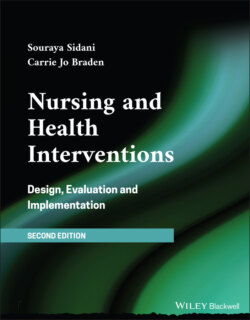Читать книгу Nursing and Health Interventions - Souraya Sidani - Страница 36
2.3.2 Structure
ОглавлениеStructure has to do with the approach and sequence for providing the intervention components. Approach represents the manner in which the intervention is given. It can be standardized or tailored/adaptive.
The standardized approach consists of giving the same intervention components, in the same mode, to all clients, regardless of the relevance of the intervention's components, activities, and mode of delivery to the characteristics and preferences of clients. The tailored approach involves customizing or individualizing the intervention to the characteristics and preferences of clients (Mannion & Exworthy, 2017). It is conceivable to provide some components and respective activities in a standardized approach and others in a tailored approach. In the example of the multicomponent intervention for chronic insomnia, the instructions of the stimulus control therapy are applicable to all clients and, thus, relayed in a standardized approach; however, setting a regular sleep–wake schedule, which is the specific component of sleep restriction therapy, is informed by clients' sleep needs and negotiated to suit individual clients' life circumstances.
The components comprising the intervention can be provided simultaneously or sequentially. Simultaneous provision implies that the components and respective activities are presented, discussed, and carried out all together at one point in time. For instance, Sidani et al. (2019) designed the multicomponent intervention for chronic insomnia in a way whereby the information and recommendations of the sleep education and hygiene, stimulus control therapy, and sleep restriction therapy were conveyed to clients in the first intervention session; clients were instructed to apply all recommendations associated with these three components simultaneously.
Sequential provision means that the intervention components are given progressively, that is, one component is introduced at a time. This is illustrated with how Holmqvist et al. (2014) designed and delivered the cognitive behavioral therapy for insomnia: Clients were exposed to the therapy's components in the following sequence: (1) psychoeducation about sleep and models or factors contributing to insomnia; (2) relaxation training; (3) concepts of stimulus control therapy and sleep restriction therapy; (4) cognitive therapy; (5) information on sleep hygiene and stimulus control; and (6) mindfulness meditation.
